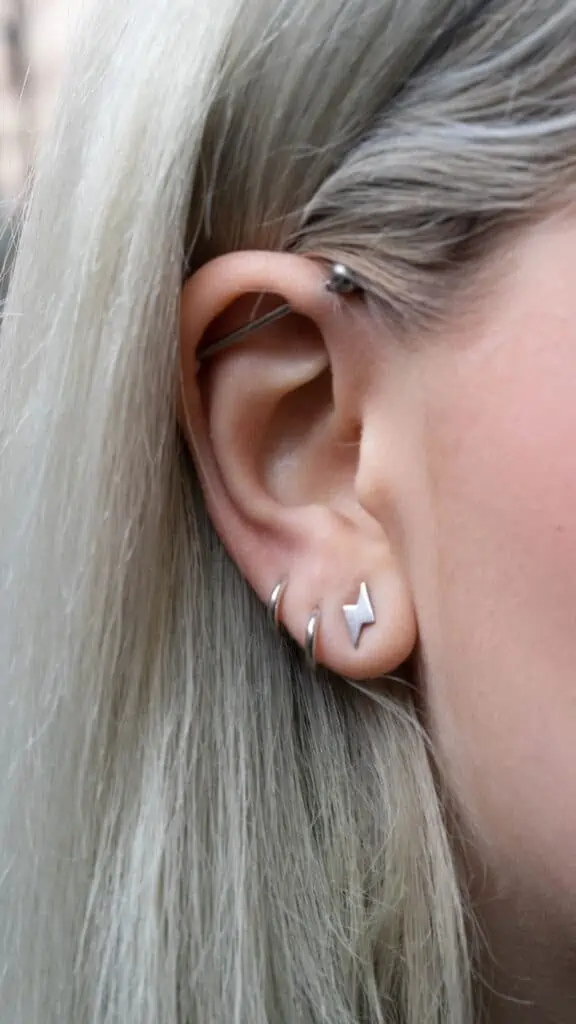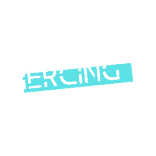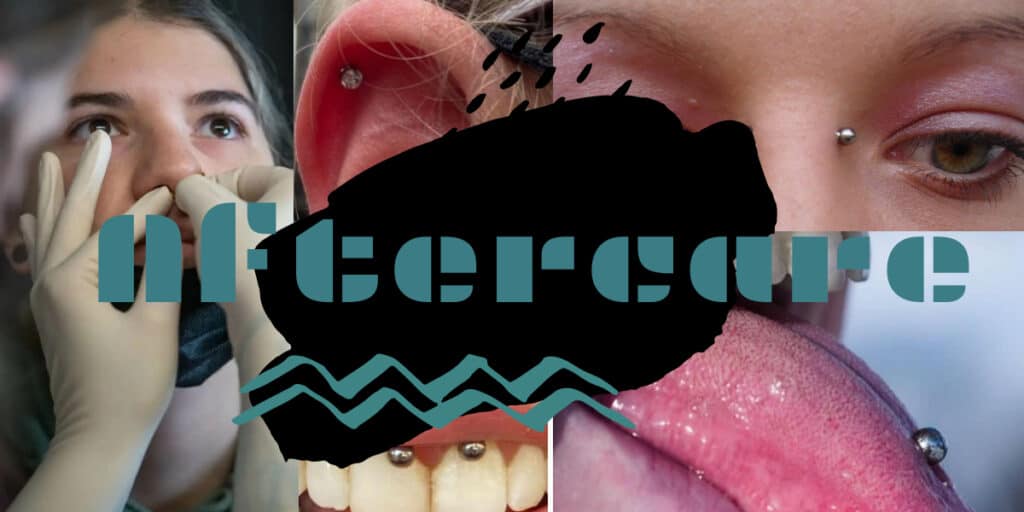The Different Types of Piercings

Introduction
There’s something about piercings that just feels intriguing. Whether it’s the sleek and sexy ear piercing, the rockstar lobe job, or the delicate tragus piercing, there’s something about them that just screams “look at me!”. But before you go ahead and get a piercing done, it’s important to understand the different types of piercings and their respective benefits. In this post, we’ll talk about the history of piercings, meaning of piercings, different types of piercings, health of piercings, piercing aftercare, and more! So be sure to bookmark this page and come back to learn everything you need to know about piercings!
Definition of piercing
A piercing is a hole in the body created by a sharp object. It can be done for cosmetic purposes, to wear jewelry, or as a form of body modification.
Piercings can be made in a number of different places on the body, including the ears, nose, navel, eyebrows and lips.
Ear piercing
Ear lobe piercings are the most popular type, and for good reason, they’re aesthetically appealing and relatively painless. Cartilage piercings, also known as ear cartilage piercings or cartilage piercings with tunnels, are a type of ear piercing in which the cartilage is pierced and then jewellery is inserted into the ear cartilage tunnels.
Rook Piercing
A Rook piercing for ladies is placed in the center of the upper part of the ear, located above the tragus in the antihelix.
Tragus Piercing
A tragus piercing goes through the small flap of cartilage that sits outside your ear canal.
Conch Piercing
A conch piercing is a piercing that goes through your ear, usually in the deep, bowl-shaped portion of the inner ear.
Industrial Piercing
Industrial piercing is a type of body modification that involves two piercings in one ear. The jewel bar goes through the two pierced places and holds the earring in place.
High-Lobe Piercing
High-lobe piercing is a type of piercing that goes through the upper part of your ear lobe.
Standard Lobe Piercing
Standard lobe piercing is the most common type of ear piercing. It involves taking a small hole in your earlobe and then inserting a jewelry piece through it. This piercer will be able to help you choose the best jewelry piece for your individual needs.
Helix Piercing
The Helix Ear Piercing is a piercing that is situated along the firm curved ridge of cartilage of the outer ear.
Daith Piercing
Daith piercing is a body modification in which an ear piercing is done on the smallest fold of cartilage in your ear right where the outer ridge of your ear meets your inner ear above canal.
Nose piercing
Nose piercings are the second most popular type of piercing. There are several different types of nose piercings out there, depending on the placement.
Austin Bar Piercing
Austin Bar Piercing is a type of piercing that goes through the tip of the nose, running horizontally. This piercing does not go through the septum in the nasal cavity – this means it’s less painful and requires less healing time than other piercings in this area.
Bridge Piercing
Bridge Piercingis a popular body modification technique that involves the insertion of jewelry through the skin on top of your nose, between the eyes.
Nostril Piercing
A nostril piercing goes through one of the nostrils, most of the time people choose the left nostril.
High Nostril Piercing
A high nostril piercing is placed higher on the nasal bridge than a normal nostril piercing.
Multiple Nostril Piercing
Multiple nose piercing is a combination of different high and normal nostril piercings.
Rhino Piercing
The rhino piercing goes vertically through the tip of the nose, sort of like an inverse septum piercing, which gives this piercing its distinctive look.
Septum Piercing
A septum piercing goes between the nostrils of the nose. No cartilage is pierced, instead the needle goes through the thin skin, just below the nasal septum.
Nasallang Piercing
The Nasallang piercing goes straight through the right nostril, septum and left nostril.
Piercings of the lip, mouth and tongue
There are many types of piercings that can be done on the lips, mouth and tongue. The most common type of piercing is the lip piercing, which is usually done on the bottom lip. Other types of piercings that can be done on the lips include the medusa piercing, which is a piercing on the center of the top lip, and the labret piercing, which is a piercing on the side of the bottom lip.
Piercings of the tongue are also quite popular, and there are many different types that can be done. The most common type of tongue piercing is the standard tongue piercing, which is done in the center of the tongue. Other types of tongue piercings include webbing piercings, which are done at the base of the tongue, and snake bites piercings, which are two piercings that are done on either side of the tongue.
Mouth piercings are less common than lip or tongue piercings, but they are still quite popular. The most common type of mouth piercing is the Monroe piercing, which is a piercing that is done on the left side of the upper lip.
The Midline tongue piercing
The vertical tongue piercing is the traditional single tongue piercing that is pierced directly through the center of the tongue using a straight barbell. This piercing has been around for centuries and is still one of the most popular piercings today.
Lower Frenulum piercing
Lower Frenulum piercingis a type of piercings that is done through the lower frenulum. This small piece of tissue separates the tongue from the floor of the mouth, making it an ideal location for piercings. The Frenulum can also be stretched or pulled during piercings to increase sensation.
Upper frenulum piercing or smiley piercing
Upper Frenulum Piercing is done on the inside of your upper lip, just above the gumline. This piercing is also known as the smiley piercing because it’s only visible when you smile.
Two Vertical Tongue Piercings
This is two tongue piercings below each other.
Horizontal Tongue Piercing
A horizontal tongue piercing involves a single piercing passing through the the tongue horizontally. They’re also sometimes called snake eye piercings or scoop piercings, and despite their fun-sounding names, these piercings are anything but simple. They can be extremely painful and difficult to heal, since they put pressure on all of the nerves in your mouth. Consequently, horizontal tongue piercers are generally regarded as off-limits by professional piercers.
Labret Piercing
A labret piercing is the name for all piercings at the lower lip.
Angel Bites piercing
Angel bitesare a set of piercings where each piercing sits symmetrically just above the upper lip.
Eyebrow piercing
Any piercing around the eyebrows are called eyebrow piercings. These piercings are relatively painless and also heal fast.
Reasons for piercing
When it comes to piercings, there are a variety of reasons why people choose to get them. Some piercings are traditional and have been around for centuries, while others are more modernized but just as popular. No matter the type, it’s important to do your research before making a decision. This way, you’ll know what the benefits and risks of the piercing are. Additionally, the placement of each piercing can vary – from your ears to your nose. It’s important to know what’s best for you and your body, and to research each piercing before making the jump. In the end, choosing the right piercing is all about personal preference!
Piercings: How to prevent complications
Here are some tips to prevent complications from piercings:
- Make sure the piercing is done by a professional in a clean environment.
- Avoid touching the piercing or putting anything else on it until it heals.
- Follow the aftercare instructions given to you by the piercer.
- If you experience any pain, redness, or swelling, seek medical attention immediately.
What are the risks of piercings?
There are a number of risks associated with piercings, including infection, allergic reaction, and scarring.
Infection is the most common complication of piercing and can occur at the site of the piercing or at any point along the healing process.
Allergic reactions occur mainly if the wrong type of metal is used for either the piercing or the jewellery.
Any type of piercing can also leave a scar if you ever decide to leave it out.
Make sure you’re ready
Make sure to wash the area, and check for any wounds or scars that might make it difficult to get pierced. Know that you’ll experience a sharp pain when the puncture is made, and if the piercing goes through cartilage, it will hurt.
Insist on safety precautions
Good hygiene is important with piercings. Make sure that the piercing needle is sterilised and that the piercing looks clean.
Take good care of your piercing
After the piercing has been done, take good care of it by cleaning it twice with a saline solution dayly during the healing process. After that, remember to properly disinfect the jewellery as well. If everything isn’t healing well then see a professional as soon as possible. In case you experience any pain or discharge from the piercing, seek medical attention right away!
Piercing prohibitions and taboos
Piercings come in a variety of shapes, sizes and colors, and they’re often regarded as controversial. For example, eyebrow piercings and tongue piercings are generally more taboo than other types of piercings in many cultures. Ear piercing are the most common type of piercing globally, followed by nose piercings. These piercings are culturally more accepted and seen as less intrusive. There’s no one definitive answer as to why different cultures have different prohibitions and taboos around piercing, but it is likely due to religious or social norms.
Health benefits of different types of piercings
Similar to acupuncture, some people believe that certain piercings can be beneficial for our health. There is however no scientific proof that corroborate these claims.
Frequently Asked Questions
What piercing hurts the most?
Piercings that are located in areas with thinner skin or closer to bone tend to be more painful. This includes piercings like the nostril, septum, and lip. Cartilage piercings like the tragus and helix can also be quite painful.
What do piercings do to your body?
Piercings cause damage to the tissue, cartilage and blood vessels in the area, which can lead to pain, swelling, and/or bleeding. Additionally, piercings can also trap bacteria under the skin, which can cause further infections.
Is piercing a sin?
According to the Catholic Church, piercing is not a sin.
What is the film piercing about?
The film Piercing is about a young piercer who starts working at a small shop in the Bronx. It follows her journey as she tries to find her place in the world, and learn about herself and the art of piercing. The film was produced by HBO Documentary Films.
Would you ever consider getting a vagina piercing?
The CDC does not recommend vaginal piercing because of the potential for infection and healing problems. A 2006 study in the Journal of Sexual Medicine found that almost half of women who underwent a vaginal piercing within the previous twelve months had some form of infection, including yeast infections, UTIs, and bacterial infections.
Jewelry: Why should or shouldn’t I get ear piercings?
The American Academy of Pediatrics does not recommend ear piercings for children until they are at least 8 years old. The body piercings may result in increased infection rates if the piercings are not done properly by a professional.
How can I make sure that my body jewelry is properly placed and doesn’t cause any problems later on?
There are a few things you can do to ensure that your body jewelry is properly placed and doesn’t cause any problems later on. First, make sure that the jewelry is the correct size for your body. Second, be careful when inserting the jewelry into your body, and be sure to follow any instructions that come with the jewelry. Finally, if you have any concerns about the placement of your body jewelry, or if you experience any pain or discomfort, be sure to consult a professional piercer or doctor.
What should I know about metal allergies and how can I prevent them from happening in the future?
If you have a metal allergy, you may experience a range of symptoms including itchiness, redness, swelling, and hives. Metal allergies can be caused by exposure to metals such as nickel, cobalt, or chromium. You may be more likely to develop a metal allergy if you have another type of allergy, such as hay fever or eczema. There are several ways to prevent metal allergies from occurring, including avoiding exposure to metals, using hypoallergenic products, and taking antihistamines.
How does a piercing heal?
A piercing heals by the process of granulation. This is when new tissue grows and fills in the space where the piercing was done. The body does this in order to close the wound. The new tissue is usually pink or red in color. It can take up to 1 year for a piercing to heal completely.
Is there a difference between earlobe and cartilage piercings?
There is a difference between earlobe and cartilage piercings. Earlobe piercings are less painful and heal faster than cartilage piercings. Cartilage piercings take longer to heal and can be more painful.
Can you explain how ear gauges work, and why they’re better than studs/daiths (or vice versa)?
There are two types of ear gauges: the taper and the plug. The taper is a cone-shaped object that is inserted into the earlobe. The plug is a cylindrical object that is inserted into the earlobe.
Ear gauges are better than studs because they provide a more secure fit. They are also less likely to fall out, and they are less likely to cause pain or irritation.
Do you recommend body jewelry that is made from real silver or titanium?
I would recommend body jewelry that is made from titanium. Titanium is a stronger metal than silver, so it is less likely to bend or break. It is also hypoallergenic, so it is less likely to cause an allergic reaction.
Conclusion
Now that you know a little bit about piercings, it’s time to learn about the different types of piercings and where they come from. In this blog, we’ve discussed ear piercing, piercing prohibitions and taboos, and health benefits of different piercings. So, what are you waiting for? Let’s get started!
FAQ
How long does it take for a new piercing to heal after getting it done?
The time it takes for a new piercing to heal after getting it done can vary depending on the individual. Some people may heal quickly, while others may take longer. Generally speaking, it takes between 6 and 12 months for most piercings to heal. It is important to follow the aftercare instructions given by your piercer to help ensure proper healing.
Which piercings are considered safe and which ones aren’t?
There are a few different types of piercings that are considered safe. These include earlobe piercings, nostril piercings, and lip piercings. Piercings that involve cartilage are considered less safe because cartilage has a limited blood supply and heals slower because of this.
Is there any danger in having more than one type of body piercing at a time, or should I wait until it heals?
There is no real danger in having multiple piercings at the same time, although it is recommended that you wait until each individual piercing has healed before adding another. This is primarily for comfort and cleanliness reasons, as it can be difficult to keep multiple piercings clean and free of infection while they are healing.
Which piercings are popular among women and which ones among men?
Some piercings that are popular among women include the nose, eyebrow, lip, and tongue. For men, common choices are the earlobe, nose, and eyebrow. Ultimately, it is up to the individual to decide which piercings they want to get.
Does the type of metal matter when it comes to piercings?
Yes, some metals are more likely to cause an allergic reaction than others.
How can I make sure that my piercings heal properly and don’t cause me any pain later on down the road?
There are a few things you can do to ensure that your piercings heal properly and don’t cause any pain later on. During the healing proces, make sure to clean the wound twice a day with a saline solution. After that, you should make sure to clean your piercings regularly with a mild soap and warm water. Also avoid touching or playing with your piercings, as this can irritate the area and delay healing. Finally, if you experience any pain or redness around your piercing, be sure to see a doctor or piercer as soon as possible to get it checked out.


Pingback: get a belly button piercing? Everything you need to know